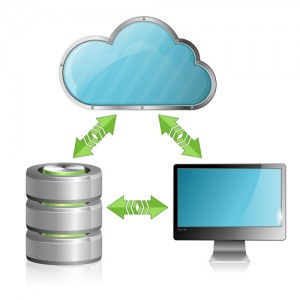Why BaaS Is Becoming Tomorrow’s Standard in Data Storage
 Using the cloud for secure Backup as a Service (BaaS) data storage is rapidly becoming a quality that potential clients look for when evaluating business partners. In a high energy business environment with ever increasing dependency on information and data storage, the consequences of data loss can be catastrophic.
Using the cloud for secure Backup as a Service (BaaS) data storage is rapidly becoming a quality that potential clients look for when evaluating business partners. In a high energy business environment with ever increasing dependency on information and data storage, the consequences of data loss can be catastrophic.
How It Works
Online backup systems operate by using agent software to compress designated data files, folders, and drives, then encapsulate the compressed data in encrypted packets and transmit them to an off-site facility where the data is stored.
The initial backup can be time consuming, but in subsequent sessions backup systems save bandwidth and time by using algorithms to scan the selected folders and drives and focus only on data files that have been added or changed since the last update.
In-House Backup Difficulties
Backing up data is nothing new in the business world. Traditionally it has been a function performed as time allowed by IT professionals within the company, and the data was stored on location. There are a number of drawbacks to this method. Three of the more prevalent are:
- cost of IT personnel,
- cost of equipment, and
- potential for total data loss.
Online backup systems provide viable solutions via the cloud to each of these persistent problems with in-house data backup.
Labor Savings
Once the agent software has been installed, the company’s IT professionals need only designate the material to be backed up and schedule a recurring time window for the backup to take place. After that, the process becomes automatic. No further active participation is needed on the part of employees. The result is less manpower and less labor cost.
Infrastructure Savings
The savings in equipment cost is immediately obvious. Eliminating the need to purchase, keep, and continuously update data storage equipment translates to a great deal of savings even after the cost of the online backup is taken into account.
Reduced Risk of Total Loss
One of the more often overlooked advantages of online backup is the reduction of total data loss risk. When data is backed up and kept on location, the original data and the backed up data are both at risk if the building is somehow destroyed. If the backup data is stored off-site, as is the case with an online backup system, the destruction of the business building does not mean that all of the business’s vital data is forever gone.
Looking Forward to BaaS and the Cloud
Any enterprise that does business over many years will learn that suffering data loss is inevitable. The deciding factor between data loss being a mere inconvenience or a serious financial disaster will depend on how well prepared a company is for the problem.
It should be noted that as the business field of play changes, the cloud becomes more essential in daily operations. Businesses that fail to adapt to the ever increasing influence of the cloud will find themselves left behind. Existing and prospective clients are becoming more conscious of whom they do business with. In increasing numbers, potential businesses are looking at survivability when choosing their partners.
Preparing For Data Loss
 Data loss incidents, when an organization suffers the loss of valuable data, can cause considerable harm to the business. The loss may be as a result of a natural disaster, fire, or theft, and the impact can be irreparable. Yet statistics show that relatively few organizations adopt robust data protection policies. This is short-sighted because sensitive and important data is held in the cloud, and its loss, even if temporary, can hurt the organization.
Data loss incidents, when an organization suffers the loss of valuable data, can cause considerable harm to the business. The loss may be as a result of a natural disaster, fire, or theft, and the impact can be irreparable. Yet statistics show that relatively few organizations adopt robust data protection policies. This is short-sighted because sensitive and important data is held in the cloud, and its loss, even if temporary, can hurt the organization.
Risk of Data Loss
The most likely reason for the loss of data is through a natural disaster, and interestingly, significant portions of the country are at risk in one way or other. Heavy flooding, hurricanes, and earthquakes have a wide geographical spread and one incident can affect a large area, so it’s important to consider not only the business location, but also the location of data servers. In addition to natural events, data may also be lost through fire and theft.
An easy way to understand the business risk is to ask one simple question: What if we lose our data?
Financial Losses
According to a 2014 Global IT Study that surveyed 3,300 respondents, 64 percent of organizations experienced data loss in the last 12 months. The research highlighted that the cost to enterprises of lost data and downtime was $1.7 trillion.
Researchers found that although a high percentage of organizations had disaster recovery plans in place, relatively few had implemented effective data protection practices and less than half employed remote, cloud-based data protection.
Impact of Lost Data
There are two aspects of data loss that affect organizations. Firstly, there’s the loss of the data itself that may include essential operational information, critical customer data, and proprietary information, all of which affects the company’s ability to function. Secondly, there is downtime that inevitably arises from the incident as the organization works to recreate or recover the data. In the worst-case scenario, an organization might have to suspend operations for a period of time, resulting in lost revenue.
Long-Term Impact
Apart from the short-term losses, businesses may incur ongoing difficulties that lead to the loss of customers, lower sales, and long-term reduction in revenue. In many instances this can mean closure or bankruptcy.
Based on the Global IT research, companies need to take the risk of data loss seriously and implement a workable disaster recovery (DR) plan.
Disaster Recovery Plan
Although a comprehensive DR plan needs to consider all aspects of disaster recovery, there can be no recovery if the data is not available. Consequently, at the core of the DR plan must be a process for ongoing data backup and remote storage. Should data be lost, this would mean that it can be recovered, operating systems restored, and business resumed with little delay.
Contingency planning must allow for the possibility of partial or complete loss of data. Additionally, apart from allowing for natural calamities, plans should factor in the risk of man-made catastrophes, such as fire, explosion, equipment failure, and data theft.
Every business faces the possibility of losing data in one way or another. It’s imperative to be ready for a disaster to strike, so that when it does, businesses are able to respond promptly and effectively to restore data and get back online.
